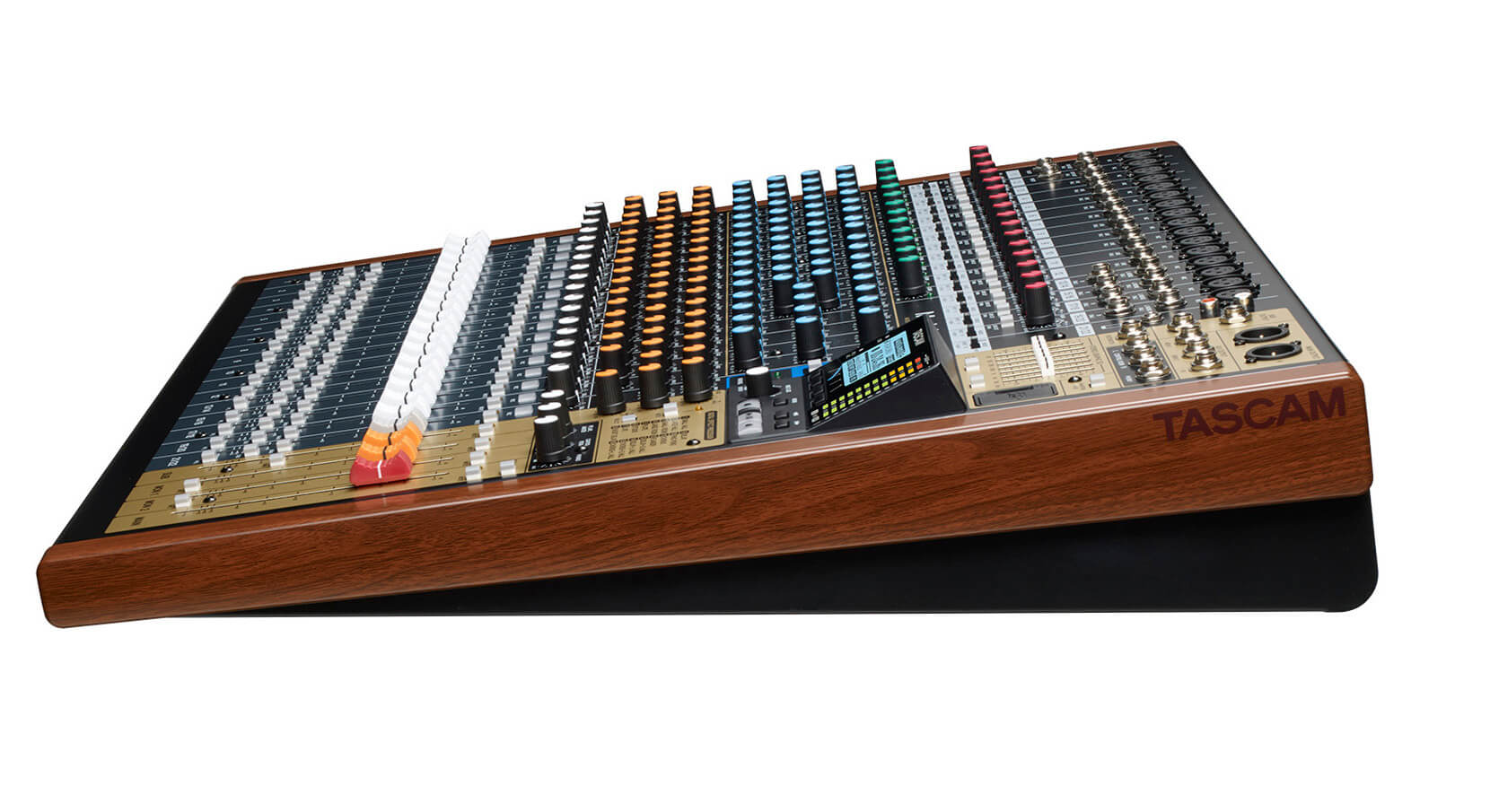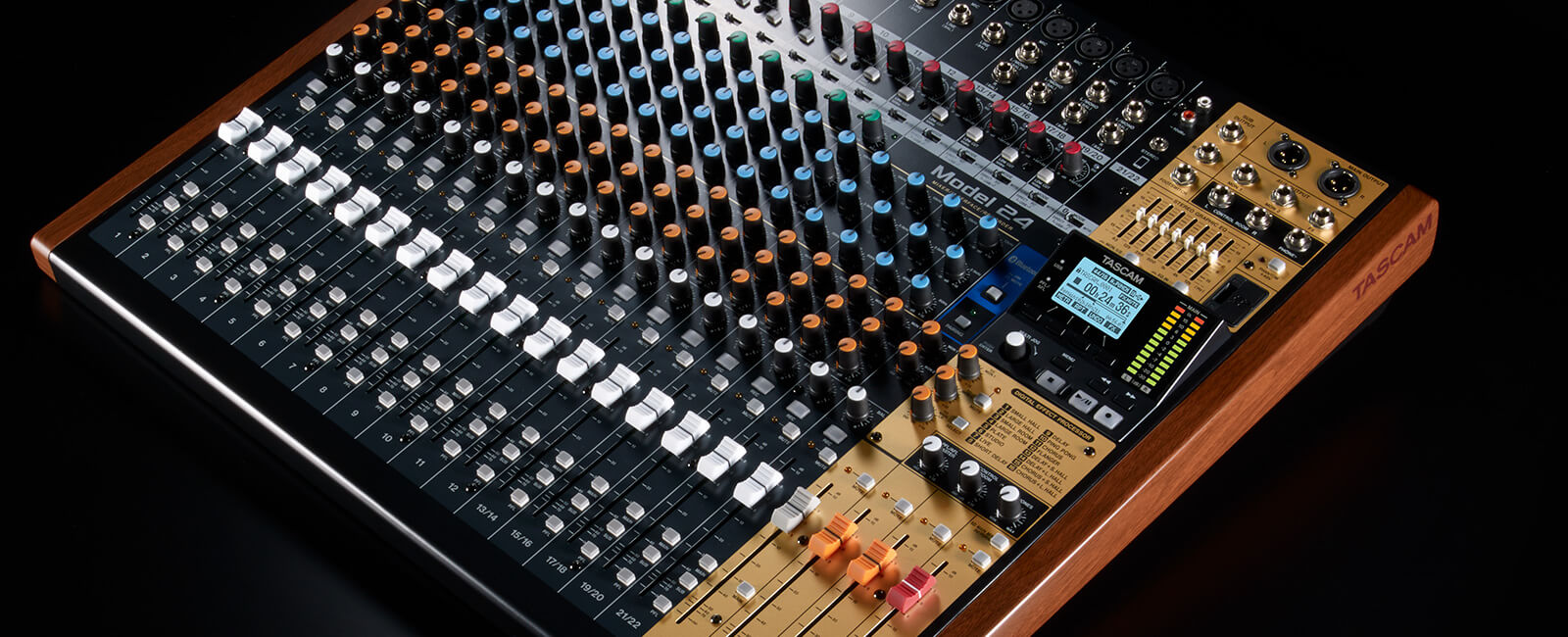TASCAM pretty much invented home recording, and their Model 24 works as a standalone recorder, a tactile mixer, as well as a DAW interface. What more could you want?
The overall landscape of it is very familiar to a traditional mixing console. Name an option and it’s there at your fingertips. Channels 1-12 each sport a Gain, Compression, 4-Band EQ, Monitor Out Buses, FX Bus, and Pan controls, along with nice big faders. Recording enabling, mute and main, sub and PFL switches are also on these channels. Channels 13-20 sport a similar configuration, minus the Compressor control, and only have a 3-band EQ section. Channels 21 & 22 are more configured for sending signals for playback, with RCA connections as well as a Bluetooth connection. Channels 1 & 2 also have dedicated instrument inputs, as well as inserts for effects with a 1/4” TRS connection. So you can get clean, direct recording of guitars and bass with no problems.
Channels 3-12 have XLR and 1/4” inputs, while 13-20 have XLR, and (2) 1/4” inputs. A great way to think of using this is putting guitars in channels 1 (and 2, if need be), 3-12 can be for drums, vocals, bass, and use 13-20 for items like keyboards/synths, or use them as effects return and sends. The mains area has a sub mix control, as well as two monitor faders, and the main control fader, a 7-band graphic EQ, along with outputs for monitors, aux outs, and headphones. And of course, there’s on-board phantom power available for condenser mics that require that extra juice. It’s a lot to take in, but everything is neatly laid out; each knob and fader feels super solid, no odd wiggles or looseness. Sound quality is great, especially with the on-board compressor to even things out right from the start.
So, this is kind of a mix of old school analog and digital, with a pretty powerful digital effects section featuring 16 variations of reverbs, delays and modulation effects to add ambience and depth to your mix. It goes a bit deeper into the digital, as the mixer also can act as a digital recorder; there’s an SD card slot which makes things super-easy to capture. Using it as a live mixer to record gigs is an excellent option.

How about recording those soundchecks? The digital display interface is pretty easy to navigate, but will take a bit of going back and forth to the manual in the beginning. In some cases, workflow wise, it might just be easier to go to something like Pro Tools or Studio One, for edits and punch-ins than try to use it as a stand-alone workstation. But the option is there, and if you need to get out of the box for a change of pace, this will bring you back to the old-school way of doing things.
Now any recordings done on the TASCAM Model 24 can be imported into the software of your choice. So, you’re recording a band live with the Model 24 in a live room or practice space, but want to mix in a different environment on a Mac or PC? Yeah, this really shines in this application. Now there is a USB connection as well, so this could also act as an awesome big-format DAW interface. Going that route offers up plenty of options. Bang for the buck, having an analog style preamp/channel strip control THEN hitting the DAW is pretty sweet. The Model 24 can also be connected and act as a mixing/control surface for a DAW as well, bringing that cool old analog feel to a new level.

At the end of the day, if you don’t want them, then no extra software or hardware add-ons are needed. It’s actually a refreshing change of pace and can get you thinking more about the song than menu-diving in your DAW. It could easily be the heart of a good DIY studio that wants to have enough inputs to do a full band, without any issues. It’s old school feel meets new cool options.
PROS:
great analog inputs and tactile feel, easy on-board digital recording and expandability
CONS:
smallish digital display
STREET PRICE:
$999
